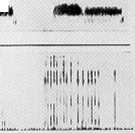232
The bird was allowed to feed for 45 s following the trill. A low frequency
noise (2 s) signalled the end of the feeding period. If the bird remained or
later returned to within 30 cm of the dish, marked by a white washable cloth,
it was surprised by the motion of a remote stick over the white part of the
floor. All birds rapidly learned to come to feed (3—5 sessions). The criterion
for training was the delivery of five ‘punishments’ per session. This criterion
was achieved in 10—15 sessions.
'Γesting
Behaviour wras observed through a one-way mirror and recorded on a 10-
channel Miniscript Z recorder. On the day before operation the behaviour
that occurred during a training session (20 trills) was continuously recorded
(45 min). On the morning before operation a test session (60 min) was re-
corded. After recovery from operation training, test and extinction (20 train-
trills with no reward) were recorded on successive mornings.
Sonagrams of the test calls are shown in Fig. 2. They consisted of the nor-
ɪi
T4;
L.lLi.
ι?
Hlii ill і I1

T?
T9
if Lf І..Є. Lt
Fig. 2. This figure shows the sonagrams (frequency, kHz against time, s) for the train-trill
(T) and test stimuli (T2_9) that were presented to the Guinea fowl.
T1, train-trill; T4, fast trill; T2, slow trill; T,, novel trill; T4, arousal trill; T7, watch wind;
T,, iambus-song: for further details see text. (The difference between T1 a>ιd T4 is that for
the former the carrier frequency is relatively stable and the elements are regularly repeat-
ed. In T4 there are early fluctuations in the carrier frequency and the elements are repeat-
ed at about 150 cps at first, but slow to about 110 cps at the end.)
More intriguing information
1. A Computational Model of Children's Semantic Memory2. The name is absent
3. AMINO ACIDS SEQUENCE ANALYSIS ON COLLAGEN
4. The name is absent
5. A Dynamic Model of Conflict and Cooperation
6. Are Public Investment Efficient in Creating Capital Stocks in Developing Countries?
7. Regionale Wachstumseffekte der GRW-Förderung? Eine räumlich-ökonometrische Analyse auf Basis deutscher Arbeitsmarktregionen
8. The name is absent
9. Structural Breakpoints in Volatility in International Markets
10. Testing for One-Factor Models versus Stochastic Volatility Models